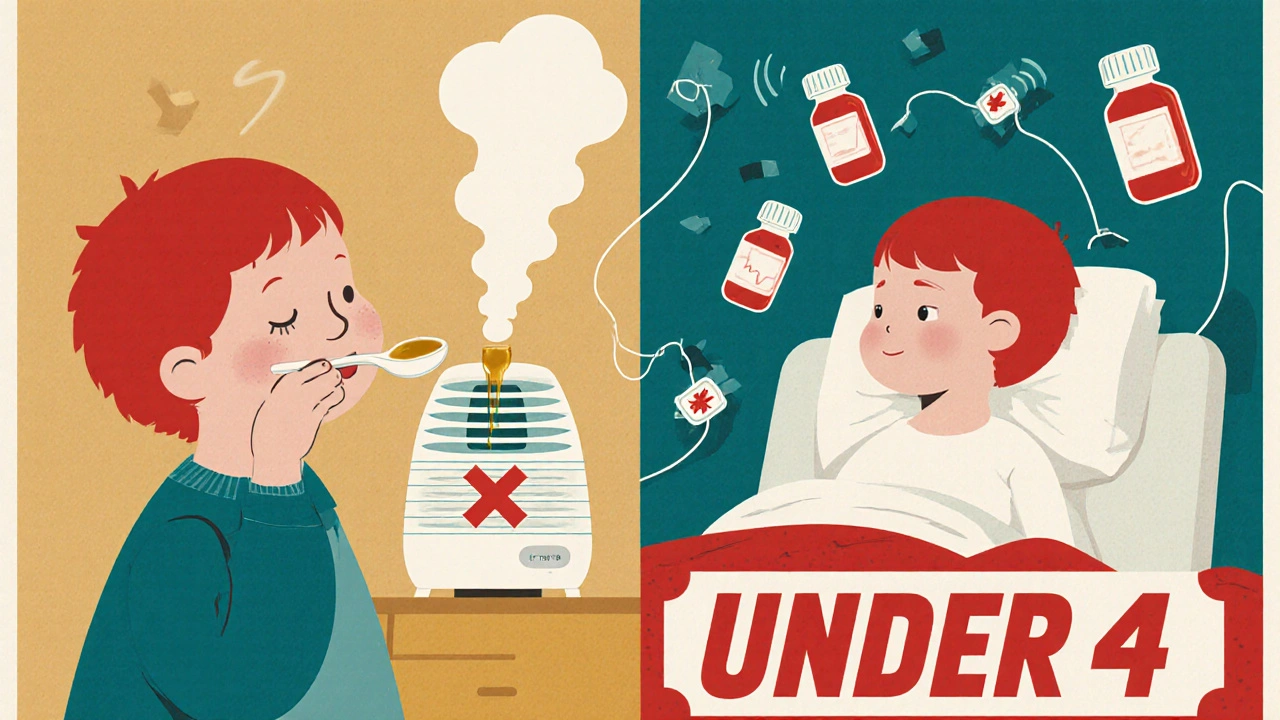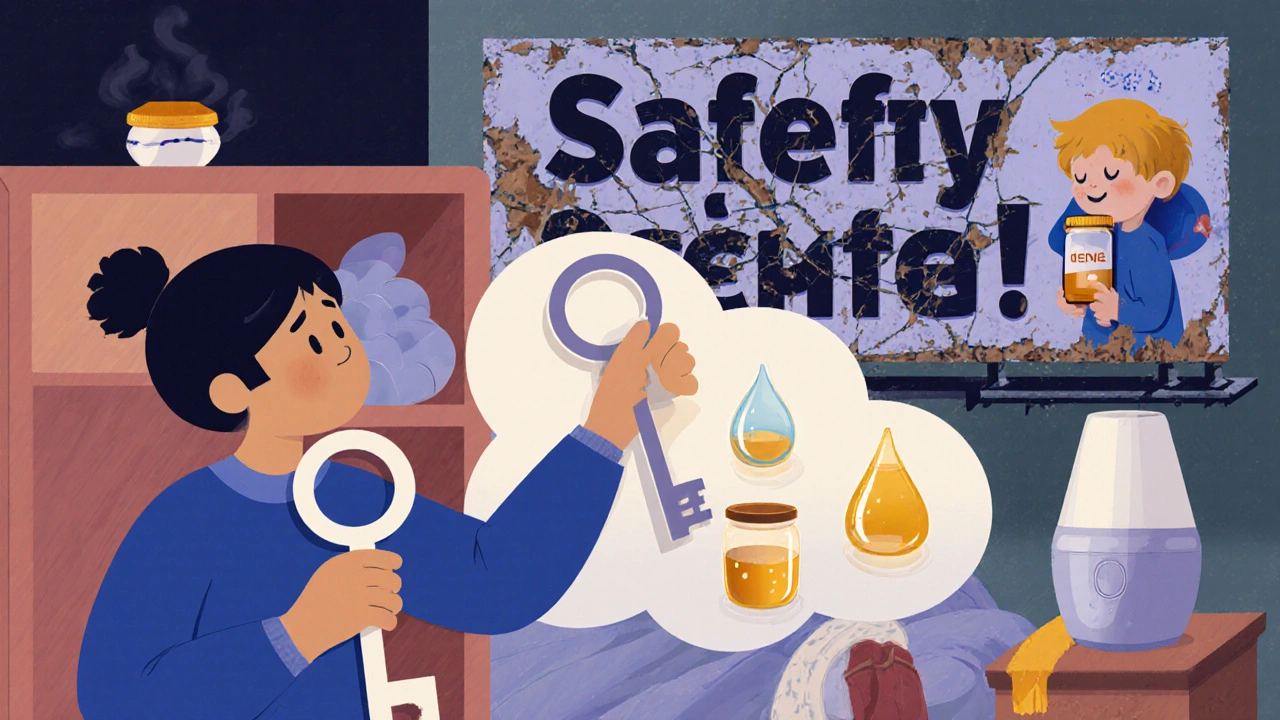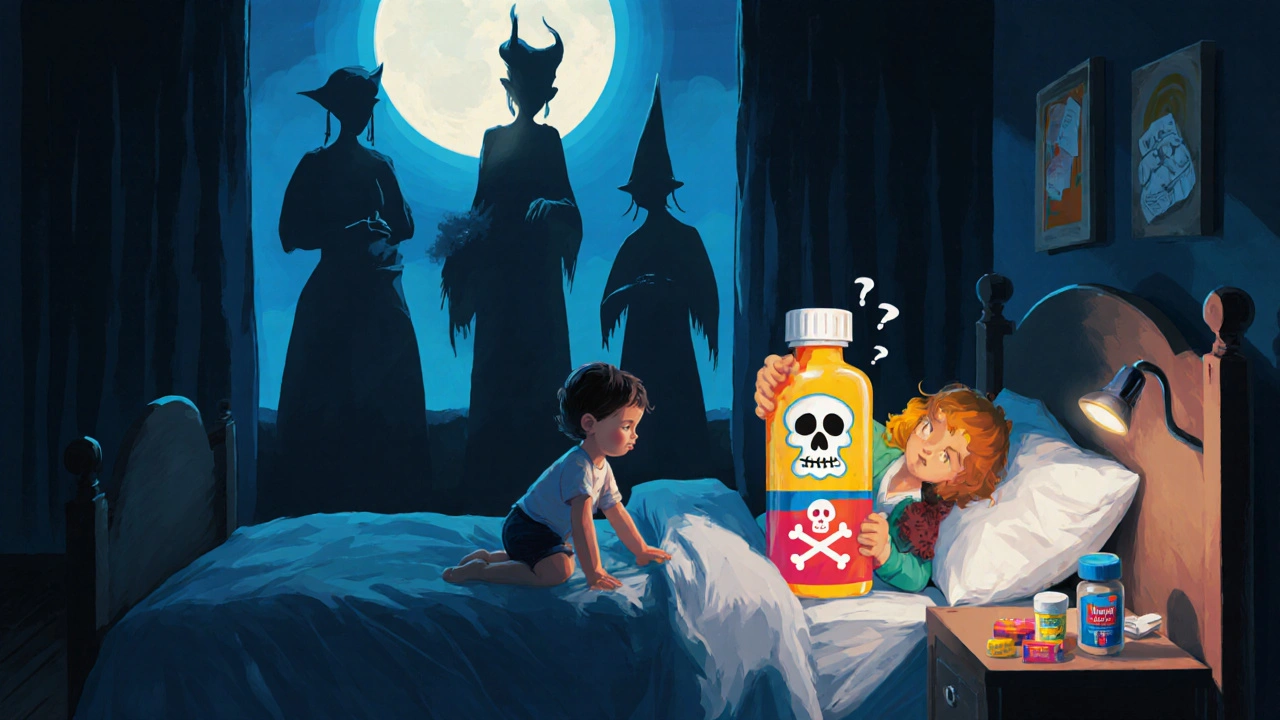Every fall and winter, parents scramble to find relief for their sick kids. A runny nose, a wet cough, a stuffy bedroom - it’s enough to make anyone reach for a bottle of children’s cold medicine. But here’s the hard truth: OTC cold medicine isn’t just ineffective for young kids - it can be dangerous.
Why OTC Cold Medicine Doesn’t Work for Kids Under 4
The FDA stopped approving these medicines for children under 4 in 2008, not because they were too weak, but because they were too risky. Manufacturers submitted dozens of studies claiming their products eased coughs and congestion. None proved it. Not one. A 2008 FDA review found no clinical evidence that antihistamines, decongestants, or cough suppressants helped kids under 12 breathe better or sleep longer. Meanwhile, poison control centers were seeing a spike in emergency visits - mostly from toddlers who got into the medicine on their own.These aren’t harmless syrups. Most contain a mix of active ingredients: dextromethorphan to suppress cough, pseudoephedrine to clear sinuses, diphenhydramine to dry up runny noses. Combine them, and you’ve got a cocktail that can slow breathing, spike heart rate, or trigger seizures. Between 2004 and 2015, over 1,500 children under 2 were hospitalized after accidental overdoses. Nearly 70% of those cases involved children who ingested the medicine unsupervised.
The Real Age Limits - And Why They’re Not Always Clear
Labels say "Do not use in children under 4." That’s the official rule. But if you look closely, you’ll find exceptions. Some brands say "under 6," others "under 12." Why? Because the FDA never banned these products outright - they just asked manufacturers to stop marketing them for young kids. So companies responded differently. One brand might remove the under-4 label entirely and just list it as "for ages 6 and up," even though the same ingredients are still inside.What’s worse? Many parents don’t even read the label. A 2021 AAP survey found 38% of caregivers still gave cold medicine to kids under 4. Why? They thought their pediatrician recommended it. But when researchers checked medical records, only 17% had actually talked to a doctor. The rest were following old habits, advice from friends, or what they saw on TV.
What Happens When Kids Take Too Much
It doesn’t take much. A teaspoon too much. Two sips from a sibling’s cup. A misread label. That’s all it takes to cross the line from harmless to life-threatening.Overdose symptoms include:
- Fast or irregular heartbeat (tachycardia)
- Extreme drowsiness or agitation
- Difficulty breathing
- Seizures
- Loss of consciousness
In 2022, U.S. poison control centers received over 12,000 calls about children exposed to cold medicines. Over 40% involved kids aged 1 to 2. Nearly 4 in 10 of those cases led to hospitalization. And yes - some ended in death. The FDA has documented at least 10 pediatric fatalities directly linked to these medications since 2000.
Here’s the kicker: most overdoses aren’t intentional. Kids aren’t trying to hurt themselves. They’re just curious. A brightly colored bottle with a sweet taste? It looks like candy. And in homes where medicine is left on nightstands, countertops, or backpacks, it’s easy to grab.

Why Weight-Based Dosing Matters (And Why It’s Not Used)
Age-based dosing is a lie. It sounds simple - "for ages 2-3, give 1 tsp" - but it’s dangerously inaccurate. Two 3-year-olds can weigh 25 pounds and 45 pounds. Giving the same dose to both? One might get a safe amount. The other could get nearly twice what their body can handle.The American Academy of Pediatrics has been pushing for weight-based dosing since 2014. It’s not complicated. If you know your child’s weight, you can calculate the right dose. But manufacturers don’t do it. Why? Because it’s harder to print on a tiny bottle. It requires parents to use a scale. And it makes marketing "one-size-fits-all" bottles easier.
Studies show age-based dosing leads to dosing errors in 23% to 37% of cases. That’s more than 1 in 3 parents giving the wrong amount. And when you combine multiple medicines - say, a cough syrup and a fever reducer - the risk of double-dosing skyrockets. Over 68% of overdoses involve more than one product.
What Actually Works - Safe Alternatives for Sick Kids
You don’t need medicine to help your child feel better. Science-backed, safe options exist - and they’re cheaper, easier, and far less risky.- Saline nasal drops: For babies and toddlers, use 2-3 drops of saltwater in each nostril, then gently suction with a bulb syringe. Do this before meals and bedtime. It’s the #1 recommendation from the AAP for stuffy noses.
- Honey: For kids over 1 year old, give 2.5 mL (half a teaspoon) of honey before bed. A 2018 Cochrane review found it reduced nighttime coughing more than placebo - and better than some OTC cough syrups. Don’t give honey to babies under 1. It can cause botulism.
- Hydration: Keep fluids flowing. Water, breast milk, or diluted apple juice. The CDC recommends adding 50 mL per kg of body weight each day when they’re sick. A 20-pound child needs about 450 mL extra per day - that’s less than two cups.
- Humid air: Run a cool-mist humidifier in their room. Keep the humidity between 40% and 60%. Dry air makes coughs worse. Moist air helps loosen mucus.
- Fever relief: If your child is uncomfortable, use acetaminophen (10-15 mg/kg every 4-6 hours) or ibuprofen (5-10 mg/kg every 6-8 hours) - but only if they’re over 6 months. Never give aspirin.
These aren’t "natural remedies" - they’re evidence-based medical advice. And they work.

What’s Changing - And What’s Coming
The tide is turning. The FDA is drafting new rules expected by mid-2025 that could require all pediatric OTC medicines to undergo clinical trials before being sold. The American College of Chest Physicians now says no OTC cough medicine should be used in children under 12. Europe has banned these products for under-6s since 2009. Switzerland banned dextromethorphan entirely in 2022.Manufacturers are responding. The market for pediatric cold medicine in the U.S. has dropped from $1.2 billion in 2007 to $840 million in 2022. Companies are shifting to adult products or natural alternatives. But the real win? New safety features. Some brands now use flow-restrictor caps that limit each dose to 5 mL - reducing overdose risk by 82%. That’s the kind of change that saves lives.
What Parents Need to Do Right Now
1. Never give OTC cold medicine to a child under 4. Not even "just once." Not even "because the doctor said so." 2. Read every label. Check active ingredients. Avoid multi-symptom products. If it has more than one medicine in it, put it back. 3. Use the dosing tool that comes with the bottle. Not a kitchen spoon. Not a medicine cup from last year. The one that came with it. It’s calibrated for the right dose. 4. Store medicine out of reach and sight. Lock it up if you have to. Kids are fast. They’re smart. And they know where the medicine is. 5. Call Poison Control at 1-800-222-1222 if you’re unsure. Don’t wait for symptoms. Don’t Google it. Call. It’s free, confidential, and available 24/7.There’s no magic pill for a cold. But there is a safe path. And it doesn’t involve medicine.
Can I give my 3-year-old children’s cough syrup if I cut the dose in half?
No. Even half the recommended dose for a 4-year-old is not safe for a 3-year-old. These medicines aren’t just stronger versions of adult drugs - they’re chemically different and can affect young bodies in unpredictable ways. The FDA has found no safe dose for children under 4. Cutting the dose doesn’t make it safe - it just makes it harder to predict the risk.
Is honey really safe for toddlers?
Yes - but only for children over 1 year old. Honey can contain spores of Clostridium botulinum, which can cause infant botulism in babies under 12 months. That’s a rare but serious condition that affects breathing and muscle control. After age 1, a child’s digestive system is mature enough to handle those spores safely. A half-teaspoon of honey before bed has been shown to reduce nighttime coughing better than many OTC syrups.
Why do some brands still sell cold medicine for kids under 6?
Because the FDA didn’t ban them - they asked manufacturers to stop marketing them for young kids. Some companies still make the product and sell it, but they label it for ages 6 or older. The active ingredients are often the same. It’s a loophole. If the bottle says "for ages 2-11," that’s not FDA-approved. Stick to the official guidance: avoid all OTC cold medicines for kids under 4.
What should I do if my child accidentally swallows cold medicine?
Call Poison Control immediately at 1-800-222-1222. Do not wait for symptoms. Do not try to make them vomit. Have the medicine bottle ready - you’ll need to tell them the name, ingredients, and how much was taken. Most poison centers can guide you through what to do next, whether it’s monitoring at home or going to the ER.
Are natural or herbal cold remedies safe for kids?
Not necessarily. Many herbal products aren’t regulated like medicines, so their ingredients and doses can vary wildly. Some contain stimulants, sedatives, or even heavy metals. Echinacea, elderberry, and zinc lozenges have little proof of benefit in children and can cause side effects like nausea or allergic reactions. Stick to what’s proven: saline, honey, fluids, and humid air.
What to Do Next
If your child is sick, focus on comfort, not cure. Colds are viral. They run their course in 7-10 days. Your job isn’t to eliminate symptoms - it’s to keep them safe, hydrated, and rested.Keep saline drops and a bulb syringe in your diaper bag. Have honey on hand for kids over 1. Know the number for Poison Control. And if someone tells you to give your 2-year-old cough syrup - tell them you’ve read the label. And you’re not taking the risk.
